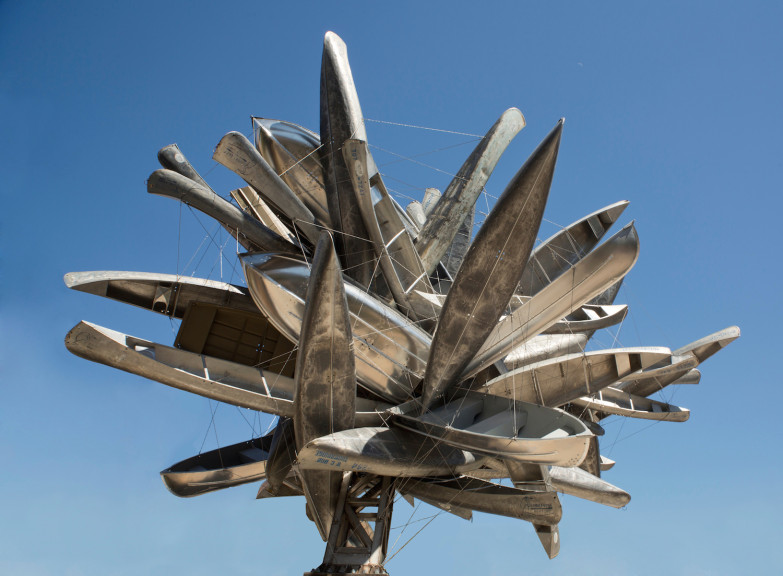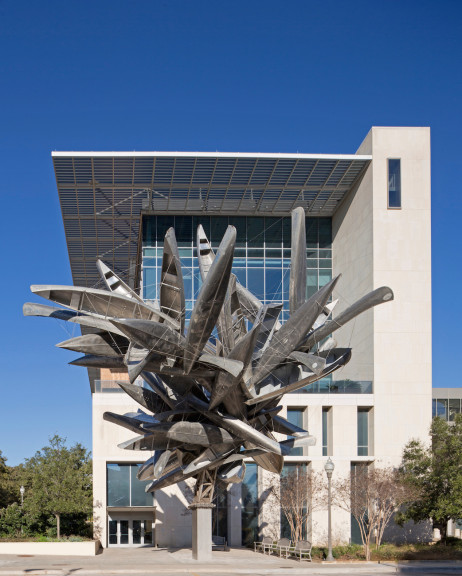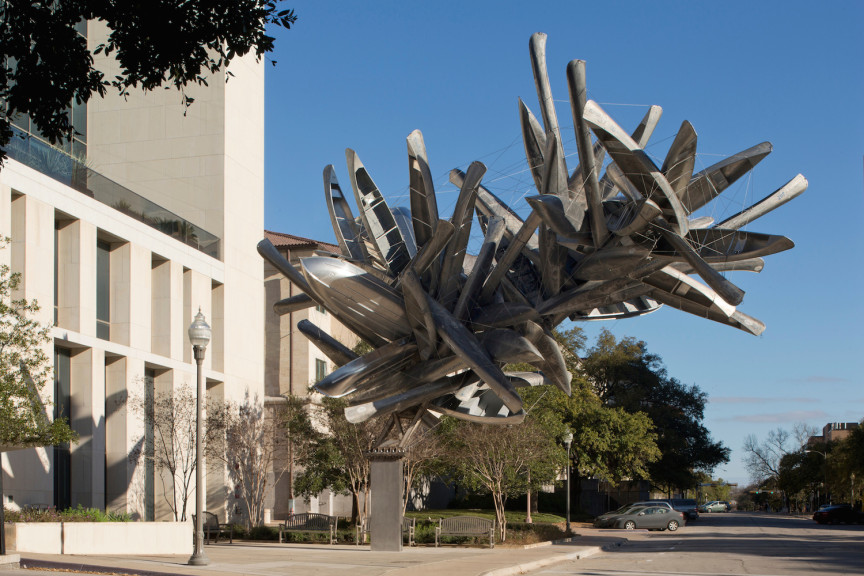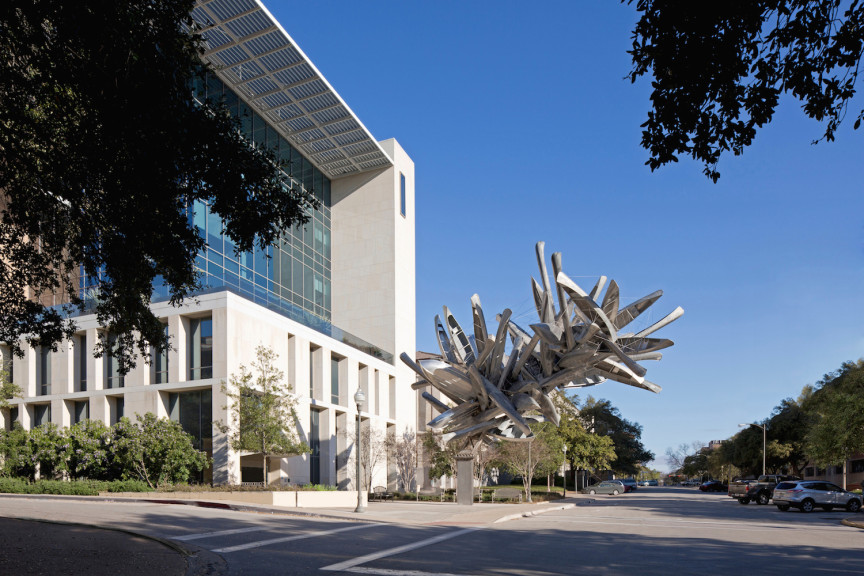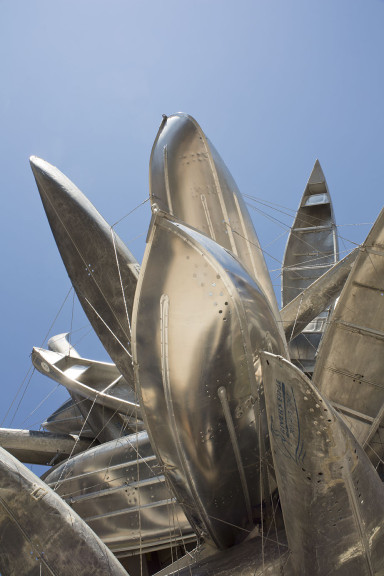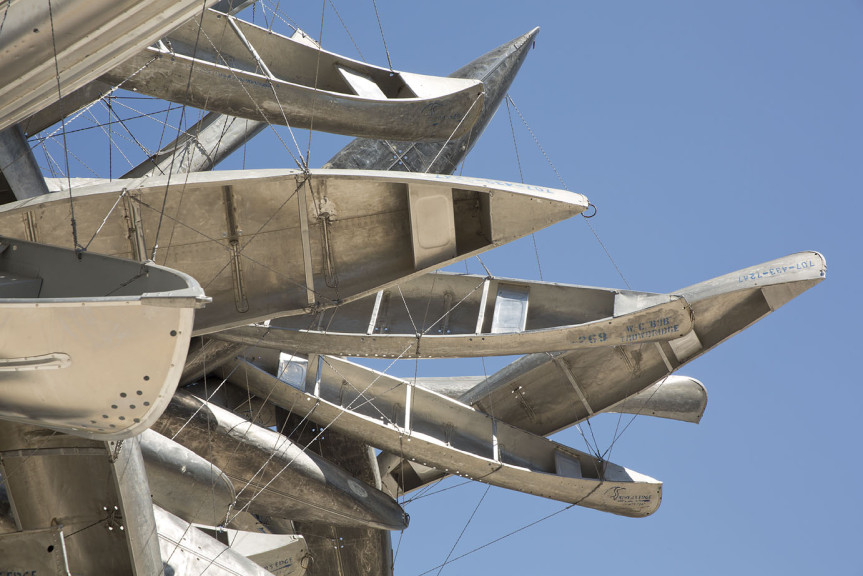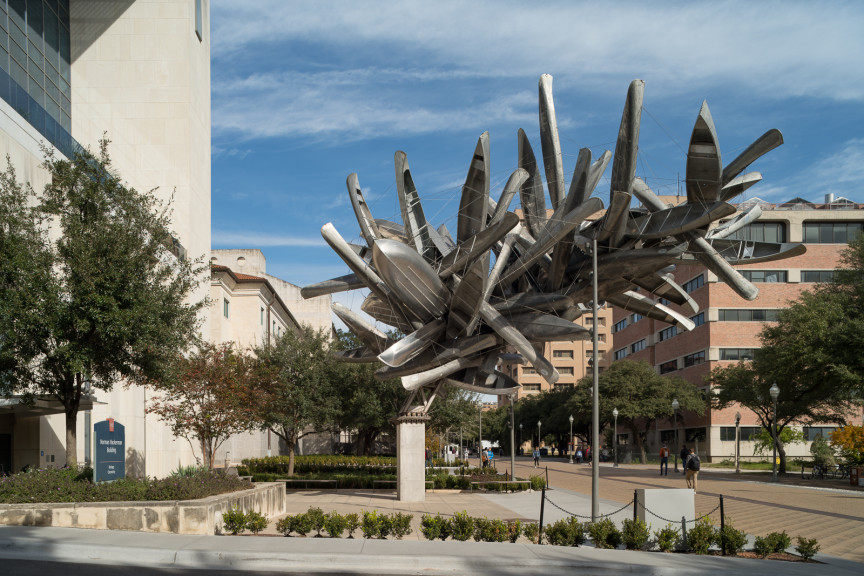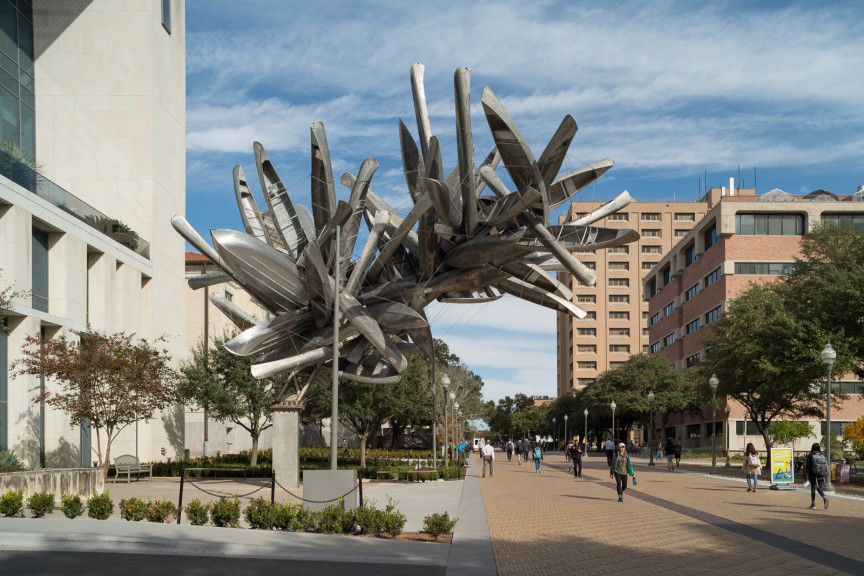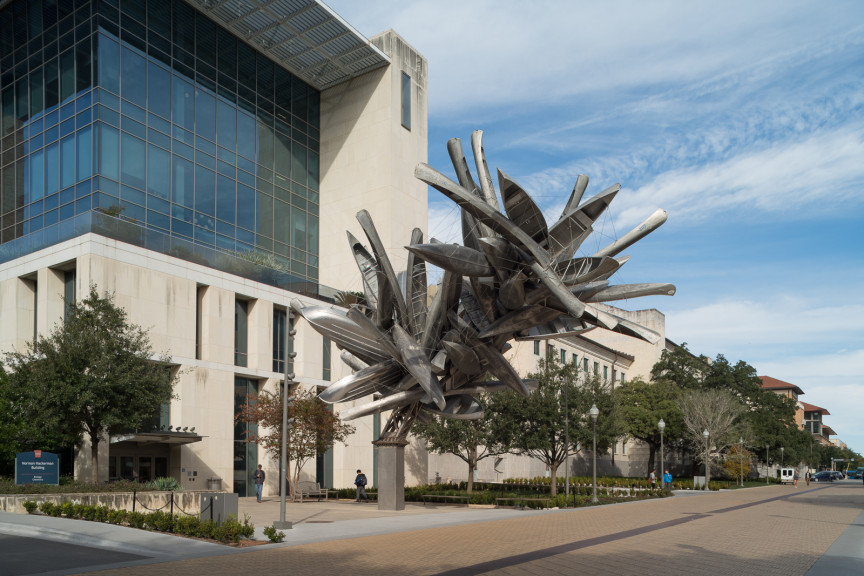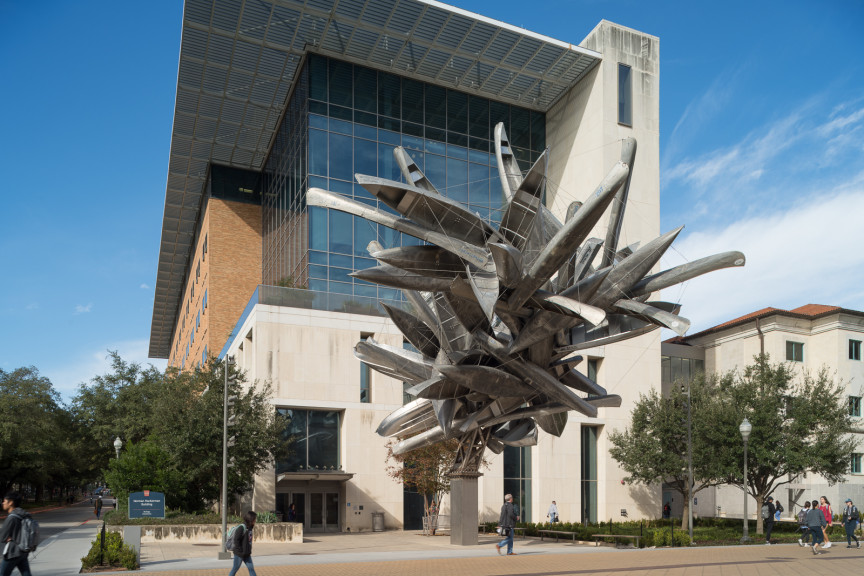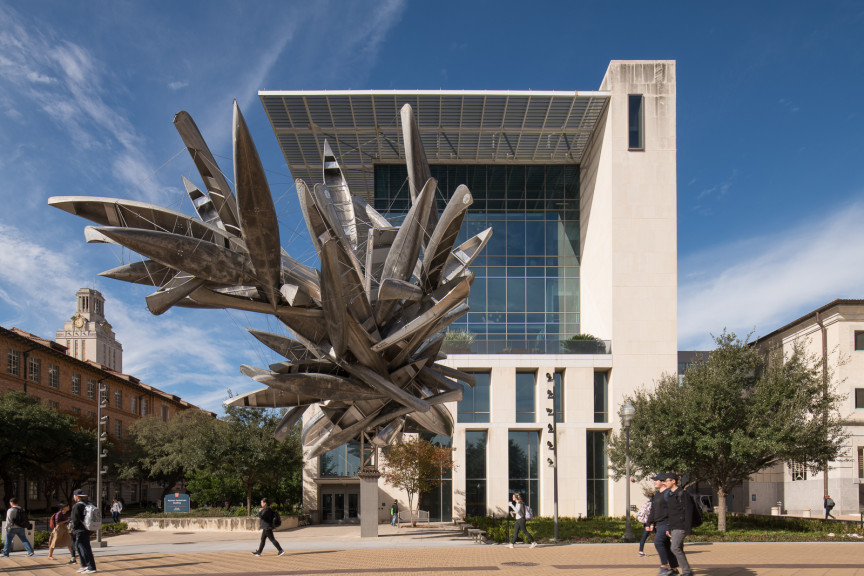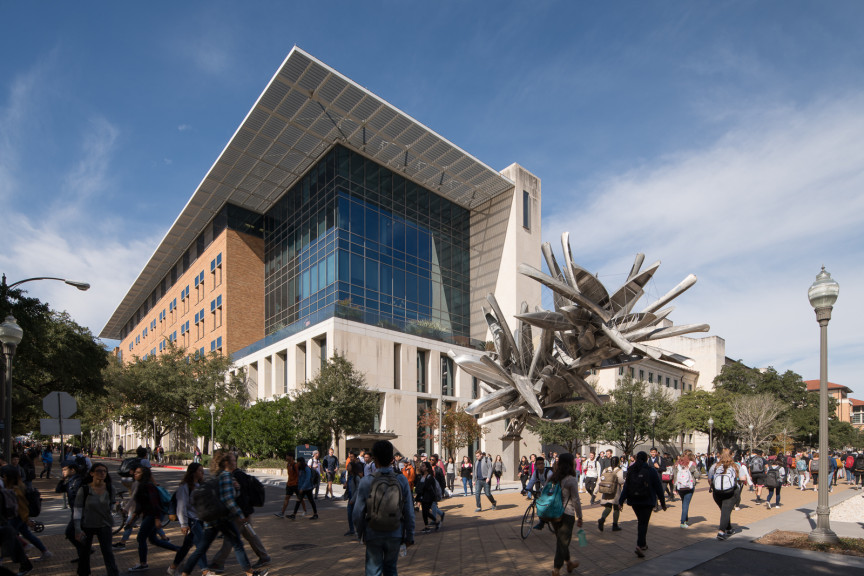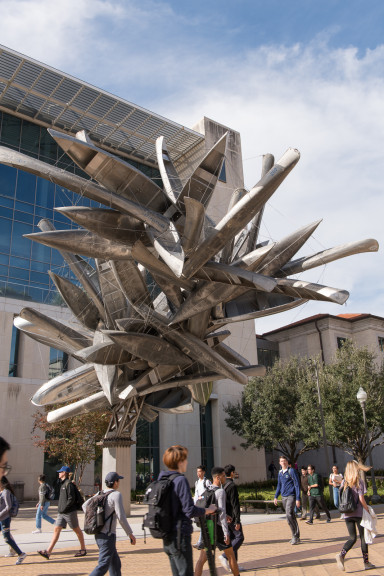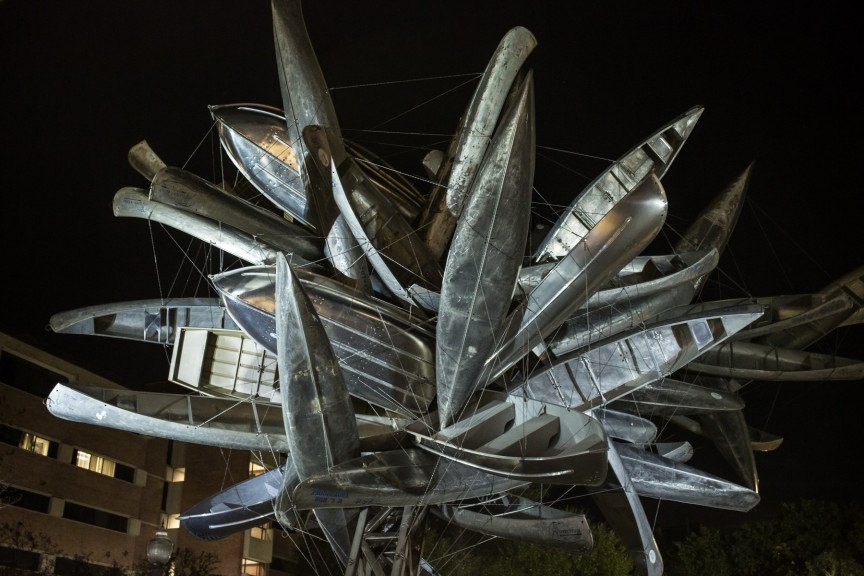Monochrome for Austin
Nancy Rubins
600 × 642 × 492 inches
Commission, Landmarks, The University of Texas at Austin, 2015
GPS: 30.287462, -97.737132
Balancing with improbable grace, Monochrome for Austin boasts seventy recycled aluminum canoes and small boats clustered at the end of a listing column. It deploys a sense of mass and scale that can be compared to a performer’s perfect timing, a characteristic that is ever-present in the work of artist Nancy Rubins. Her sculptures combine surpassing delicacy and indomitable strength, a polarity that is even more striking when encountered outdoors.
While still a student in the early 1970s, Rubins experimented with sculpture by using wet clay to stick coffee cups to suspended tarps; the cups popped off as the clay dried. In another project, a hybrid of sculpture and drawing, she used a small electric fan to create a work that involved graphite-covered paper spattered with red paint. More recently, an exhibition of sprawling sculptures made from vintage animal-shaped playground equipment was titled Our Friend Fluid Metal (2014), referencing the molten phase of the constituent metal. Porous boundaries between disciplines and the fluidity of the mediums themselves are qualities that appeal to Rubins.
By the late 1980s, Rubins’ constructions had reached colossal proportions. She added trailer homes, water heaters, and mattresses to the materials tethered together, and, later, fighter-jet wings and fuselages. By the mid-1990s, Rubins had begun to assemble brightly colored fiberglass canoes and kayaks into oversized bouquets that flower overhead with exuberance. The Monochrome series, which began in 2010, brings to the fore the grace of the unpainted metal forms. Examples from the series can be found at the Buffalo AKG Art Museum (formerly the Albright-Knox Art Gallery), New York; Gateway Park at the Navy Pier, Chicago, Illinois; and l’Université Paris Diderot, France.
The vessels evoke a different kind of movement and life than Rubins’ earlier work. In contrast to the thundering flight of retired military aircraft, canoes glide gently through the water, suggesting a kind of simple solitude. Swirling on currents of air, the canoes in Monochrome for Austin are removed from their associated landscape and combined in a visually precarious mass, giving the impression that they are suspended in time and space.
LEARNING AT HOME WITH LANDMARKS
Bring the Landmarks collection into your home-learning environment. Check out how you can engage with this work by browsing the learning resources featured on this page:
- View Photo Gallery - Click on the arrows on the sides of the image above to to view images of the work. Spend time on each photo and examine details carefully as if you were with the work in person.
- Play Audio Guide - Select “Play Audio Guide” in the upper right corner to hear a short audio guide about the art and gain a deeper understanding of its meaning.
- View Videos - Select “View Videos” to watch a 3-minute video with the artist and to understand their process.
- Activity Guides - Choose the activity guide below best suited for young learners in your home.
Still have questions or want to share your Learning at Home with Landmarks experience with us? Keep the conversation going by tagging Landmarks on social media.
ACTIVITY GUIDES
Monochrome for Austin
Nancy Rubins
Subject: Interpreting meaning in a work of art
Activity: Creative writing
Materials: Pen or pencil and paper
Vocabulary: Context, narrative story, persuasive story
Public works of art like Monochrome for Austin are meant to be seen by everyone. Nancy Rubins makes sculptures like this for locations all around the world. If you don’t know what a work of art means, try to imagine why the artist created it and why he/she used certain materials. If you’ve seen something similar, what did it mean to you and how did it make you feel?
Do you have to know the story behind a work of art in order to enjoy it?
Do your past experiences help you to understand and appreciate a work of art more?
Come up with a newspaper headline for Monochrome for Austin. Just like those for real newspapers, it should be short and grab the reader’s attention. Write a short article about the history of the sculpture or artist. Be creative! It doesn’t have to be a true story. You or a friend can draw an illustration for your story.
Context - A set of facts that help interpret a work of art
Narrative story - A story based on a real or imagined event
Persuasive story - A story that tries to convince the reader to make a choice or take action
Monochrome for Austin
Nancy Rubins
Subject: Shapes and Space
Activity: Seeing Double!
Materials: Pictures below and your imagination
Vocabulary: Materials, space
Some artists create works of art that make you take a second look! Nancy Rubins takes boats and canoes that you normally see in the water and puts them in the air.
Can you name other materials that artists can use to make sculpture?
Have you seen other sculptures that are made out of unusual materials?
Do you like to see works of art that make you take a second look? Why?
Download the activity guide and look at the small drawings. Explain what you see. Use your imagination to come up with more than one answer.
Try drawing your own simple pictures and let your friends imagine what they could be.
Monochrome for Austin is made from 70 aluminum boats and canoes.
Now look back at Monochrome for Austin and describe what you see. Does it look different to you now?
Materials - The supplies artists use to make a work of art. Paint, chalk, wood, and stone are all materials.
Space - The area in and around a sculpture.
Monochrome for Austin
Nancy Rubins
Subject: Form and balance
Activity: Toothpick sculptures
Materials: Play dough and toothpicks
Vocabulary: Gravity and balance
You can make a sculpture out of almost anything. Artist Nancy Rubins uses everyday things like toasters, hairdryers, and even playground equipment. In Monochrome for Austin she used canoes and boats.
Can you guess how many canoes and boats she used?
If you could make a sculpture out of anything, what would you choose?
Why do you think Nancy Rubins used boats and canoes?
Pinch off pieces of play dough about the size of small marshmallows and roll them into balls. Stick a toothpick into a play-dough ball. Now stick another ball on the other end and add another toothpick. Try constructing a pyramid out of toothpicks by using the play-dough balls to connect the toothpicks. Now use your imagination to build your own sculpture.
Nancy Rubins used 70 canoes and small boats to make this sculpture.
See how each boat is attached in Nancy Rubins’ sculpture. What is holding the sculpture in place? Gravity is always pulling things down to earth. When you are building your toothpick sculptures, try to think of the best way to keep them from falling.
Gravity - Force that holds everything to the ground and causes things to fall toward the ground
Balance - An equal distribution of weight so that structures will stand
MORE INFORMATION
A sculptor who salvages the unlikeliest of everyday objects, and also a draftsman who uses paper and graphite as sculptural materials, Nancy Rubins is well practiced in upending tradition. Hoisting big, heavy things overhead, where they balance with improbable grace, she deploys a sense of mass and scale that can be compared to a performer’s perfect timing. In fact, there is a kind of physical comedy in some of her work, early examples in particular. But it has always been balanced with a literal expression of gravitas: even at its most buoyant, the sculpture’s material and emotional heft—its physical drama—is commanding. And those works that are labeled drawings share the physical presence and spatial dynamism of the sculptures in the round.
The components of Rubins’ monumental sculptural works have ranged from household appliances to airplane parts, held together by slender steel cables. As in Monochrome for Austin, also in the Landmarks collection, in which recycled aluminum canoes cluster at the end of a listing column, her sculptures combine surpassing delicacy and indomitable strength, a polarity that is the more striking when encountered outdoors. There, its fearless balancing acts can be seen in relationship to the built environment, from which it draws its sense of scale and mass. Prominent among those who have challenged conventions of public art, Rubins is distinguished for work that expands the scope of sculpture in the civic realm.
Born in Naples, Texas, in 1952, and raised in rural Tullahoma, Tennessee, Rubins attended the Maryland Institute College of Art (MICA), where she completed a BFA in 1974. While majoring in painting she also worked a great deal in clay, and was particularly impressed by the work of Robert Arneson, a visiting artist who headed the graduate ceramics program at the University of California, Davis. After graduating from MICA, Rubins entered the program at UC Davis, completing her MFA there in 1976. In a recent interview with Xandra Eden, Rubins said she relished the relatively small and quiet working environment at Davis, and, especially, “the northern California funk aesthetic, which, to me, seemed like a kind of funny and vulgar answer to Pop. I liked the earthiness and rawness of it.” Although she would never produce the figurative work favored by Arneson and others associated with California Funk, Rubins fully absorbed its insubordinate spirit.
Rubins stayed in Northern California for a few years, but by the late 1970s had been drawn to New York. There she began making spectacularly massive assemblages of domestic appliances—fans, clocks, TVs, toasters—embedded in looming walls and mushrooming towers of concrete. A teaching opportunity brought Rubins back West in 1982, when she joined the faculty at UCLA, and she has remained in southern California ever since. When she arrived at UCLA, her colleagues included the mischievous conceptual sculptor Charles Ray (who invited her), Chris Burden, then known for physically grueling performance work (Rubins later married Burden, who died in 2015), and Paul McCarthy, master of scabrous videos and installations. These associations proved instrumental, but as at Davis, Rubins maintained a vigorous independence.
Early on, Rubins explored ways of transgressing boundaries between mediums. A project of 1976 involved heavily graphite-covered paper spattered with red paint, and a small electric fan implicated in the work’s creation. Drawing and Sawhorse (1975) featured a large sheet of paper, also thoroughly covered in graphite, that was draped over a sawhorse so as to suggest an animated form; two protruding sawhorse legs made it look vaguely bovine, as did a boxy, head-like extension of the graphite-covered paper. In Drawing (1974), a penciled sheet of paper was simply slung over a length of heavy rope as if it were laundry a clothesline. These and other hybrids of sculpture and drawing introduced a way of using paper to which Rubins would return in the 1990s.
Paradoxical qualities were apparent from the start in the fully sculptural work as well. What has held it together since the mid-1980s is not the brute cohesion of concrete but steel cable held in tension, as in suspension bridges. In other words, the sculptures are bound—often in dramatically cantilevered configurations—by active relationships among parts. “I’ve often felt . . . a relationship to the work of Kenneth Snelson and Tensegrity since what I’m making is held together by tension,” Rubins recently told Flash Art, citing a sculptor of elegant geometric constructions, and a term coined by the radical designer and inventor Buckminster Fuller. Moreover, the physics that keeps these seemingly impossible concatenations of heavy objects in the air is plain to see. Talking with Xandra Eden, Rubins explained, “In my work . . . you see every twist of every wire and every hole drilled into every object, and how it attaches to the stainless steel structure—or not. Although the sculptures can appear to defy gravity and, perhaps, have a sense of energy that seems to be expanding or contracting, there is a clear and transparent view of what allows them to exist.”
These kinds of constructions had reached truly colossal proportions by the late 1980s, as in Another Kind of Growth (1988), which added a trailer home to the materials Rubins strung together. In 1992, she was represented in the much talked-about exhibition Helter Skelter, organized by Paul Schimmel at the Los Angeles Museum of Contemporary Art, with the epic sculpture Trailers & Hot Water Heaters (1992). Soon fighter jet wings and fuselages were among Rubins resources as well, lending the work associations to power as well as grace, and a kind of propulsive energy that evokes J. G. Ballard’s novels of calamitous beauty and Paul Virilio’s theorization of violence and speed. These sculptures gave way in turn to others using bound mattresses sandwiched around squashed masses of frosted cake—materials that are thoroughly domestic and yet, in their overpowering abundance and imminent spoilage, still deeply disruptive. By the middle of the following decade, Rubins had begun to assemble brightly colored fiberglass canoes and kayaks into outsize bouquets that flowered overhead with a less aggressive kind of exuberance. “The boats behave beautifully in the air,” Rubins observed with some surprise in a 2006 interview for the New York Times. Indeed, the impression that they are floating high above on currents of air places us viewers in a dreamily underwater state: we are kept alert—the canoes are, after all, big and bold, and their balance seems a little precarious—but we are also made to feel, like the boats, suspended in time and space.
Monochrome for Austin, 2015
The “Monochromes” series, comprising assemblages of unpainted aluminum canoes, began in 2010; in addition to the sculpture commissioned for UT Austin, it includes examples in Buffalo, Chicago, and Paris. By forgoing color, Rubins divorces the sculptures from painterly qualities that have in the past caused critics to compare her work to John Chamberlain’s sculptures of compressed and cut-up auto parts, which have been linked in turn with the slashing compositions of Abstract Expressionism. In Rubins’ “Monochromes,” the connecting steel cables are slightly more prominent than in her previous work, forming linear networks that provide a counterpoint to the lean but substantial metal boats. In these darkly gleaming sculptures, the cantilevered, gravity-defying forms, like the playground animals in “Our Friend Fluid Metal” (2014), seem a little melancholy, and a little menacing. There is once more an association to warplanes, again nearly subliminal; some of the canoes were made by the Grumman Corporation, a major military supplier that produced the jet planes Rubins used earlier. But these vessels also evoke a different kind of movement and life: in contrast to the thundering flight of old military aircraft, canoes glide silently through the water, and speak of a kind of virtuous solitude. A single paddle is enough to guide them, and their footprints are small.
Drawing, 2007
Another link the “Monochromes” sustain is with the drawings that Rubins began making around 1990. Generally attached directly to the wall, sometimes spanning corners and occasionally also pinned to the ceiling, or allowed to spill onto the floor, these fully three-dimensional works are robust survivors of a working process that leaves them battered, gouged, and ripped; pinned and re-pinned; and, above all, covered side to side and top to bottom in furiously drawn strokes of dark glistening graphite. Rubins creates the drawings on the floor, going through quantities of rectangular pencils, sharpened with utility knives, and sheet after sheet of heavy stock. Variously pleating, scoring, and abrading the paper so that it catches subsequent pencil strokes with scabby, matte depth, she attacks these surfaces to within an inch of their lives. The resulting rough-edged configurations, gathered into folds, resemble sheets of gleaming lead. As with the early drawings on sawhorses, these later works on paper sometimes assume a vaguely figurative aspect: analogies have been made to big raptors, soaring aloft or springing for flight—and, more than once, to the Winged Victory of Samothrace. Even more primordial are the associations invoked by the graphite, which lends a mineral glint to the surfaces of the drawings, and a sense of seismic collision to the constituent sheets’ abutted edges.
Rubins’ works on paper are not alone in straddling a boundary between sculpture and drawing. Richard Serra’s drawings, in particular, have often been cited in comparisons; both artists employ heavy paper densely covered with black pigment, and both are engaged with gravity as literal physical force and as metaphor. But their differences are significant: Serra’s preferred medium is oil stick, which creates a deep, lightless black, and his drawings seem to weigh much more than they actually do. By contrast, Rubins uses pencil to engage light in a way that makes her drawings’ surfaces expand; the illusion they create is of exaggerated size, not weight. Nor do they conform, like Serra’s, to the rectangular shape of a conventional sheet of paper: they are not discrete objects—they cannot be framed; they are not, in any ordinary way, images. Leavened by exuberance, their mood differs strongly from that of his works as well. Disassembled after exhibition, to be reconfigured for subsequent installations, Rubins’ drawings are as mercurial as Serra’s are obdurate.
Comparisons with other artists are also telling. Michelle Stuart’s early paper works, in which heavy sheets of paper are imbued with rusty earth ground into their surfaces, then hung floor-to-ceiling in draped layers, have some of the same geological references as Rubins’. El Anatsui’s glittering tapestries of woven bottle caps, are, like Rubins’ drawings, reconfigured each time they are hung. Both these artists share with Rubins an easy disregard for distinctions between two- and three-dimensional work.
Like all her drawings, the untitled example of 2007 in the collection of The University of Texas at Austin is lustrous and dark, absorbing and deflecting light in a way that complicates its contours. Its jagged edges point vigorously up and out, like sharp metallic teeth, although the drawing’s profile is also suggestively animated; its several constituent sheets gather to form a deeply shadowed area at its heart.
Knifing through the air with similarly vivid grace, “Monochromes” like the one on the UT Austin campus are more inward in character than preceding sculptures. Most of the decommissioned objects in Rubins’ sculptures involve action and energy, and, as always, that energy—potent if less noisy than in some cases—is latent in the “Monochromes.” But it is now a little restless, like a spirit hovering between object and image, presence and memory. At once massive and ghostly, the Monochrome for Austin has something of the grandeur and authority of traditional monumental sculptures, with their invocation of ancestral figures and shared references. And it also has the wily aspect of a half-remembered but cherished personal object that successfully eludes capture. The same mercurial nature, as of a fish flashing below the surface of water, can be seen in Rubins’ drawing. Escaping easy definition, it gains the advantage of perpetually renewable surprise.
Nancy Princenthal is a New York–based art critic and former senior editor of Art in America. She has written and lectured extensively on leading women artists such as Agnes Martin, Petah Coyne, Hannah Wilke, and Nancy Rubins. Princenthal is co-author of After the Revolution: Women Who Transformed Contemporary Art (2007) and The Reckoning: Women Artists of the New Millennium (2013). She is currently on faculty at the School of Visual Arts, New York.
Finkel, Jori, “A Bouquet of Boats Blooming at Lincoln Center,” The New York Times, 25 June 2006, AR 30.
Hamer, Katy Diamond, “New York Tales . . . Nancy Rubins,” Flash Art, 28 July 2014.
"In Conversation: Nancy Rubins and Eric Shiner," Gagosian Gallery, 9 August 2021. https://gagosian.com/quarterly/2021/08/09/video-interview-nancy-rubins-and-eric-shiner/
“Interview, Nancy Rubins and Xandra Eden,” in Nancy Rubins: Drawing Sculptures Studies (Greensboro: Weatherspoon Art Museum; Munich and New York: Prestel, 2014), 123.
Nancy Rubins. Introduction by Hugh Davies, essays by Kathryn Kanjo and Lisa Liebmann (San Diego: Museum of Contemporary Art, 1995).
Nancy Rubins: Work. Essays by Céline Flécheux and Dave Hickey (Göttingen: Steidl, 2012).
Landmarks commissioned artist Nancy Rubins to create a site-specific sculpture on the northwest corner of 24th Street and Speedway Drive. Composed of 70 aluminum canoes and small boats, the sculpture, titled Monochrome for Austin, draws its support from a steel armature and intertwining cables. Each boat was individually positioned by Rubins and her crew of five over a three-week period. Standing at 50 feet tall, it is the largest sculpture in the collection and will feature prominently when future plans for a scenic, pedestrian-only Speedway are realized.
Funding for Monochrome for Austin was provided by the capital improvement project for the Norman Hackerman Building. This project was the result of a collaborative effort among many, but Landmarks would like to give special thanks to the following:
Leadership
Andrée Bober and Landmarks
Pat Clubb and University Operations
Douglas Dempster and the College of Fine Arts
Linde Hicke and the College of Natural Sciences
Landmarks Advisory Committee
William Powers and the Office of the President
Bob Rawski and the Office of Facilities Planning and Construction
David Rea and the Office of Campus Planning and Facilities Management
Frederick Steiner and the Campus Master Planning Committee
Project Team
Nisa Barger, project manager, Landmarks
Andrée Bober, curator and director, Landmarks
The Beck Group
CO Architects
Jaime Garza, Nabih Youssef Structural Engineers
HMG & Associates, Inc.
Nancy Rubins, artist
Sasaki and Associates
Keith Westmoreland, Office of Facilities Planning and Construction
Special Thanks
Dean Anes, Gagosian
Colin Cook, Nancy Rubins Studio
Deb Duval, event coordinator
Michael Johnson, Nancy Rubins Studio
Nick Nobel, external affairs, Landmarks
Nancy Princenthal, curatorial contributor
Tim Rogeberg, Nancy Rubins Studio
Christine Schneider, Nancy Rubins Studio
Joel Searles, Nancy Rubins Studio
Bill Shambaugh, Nancy Rubins Studio
Stephanie Taparauskas, development, Landmarks
Jennalie Travis, development, Landmarks
Catherine Zinser, education, Landmarks

